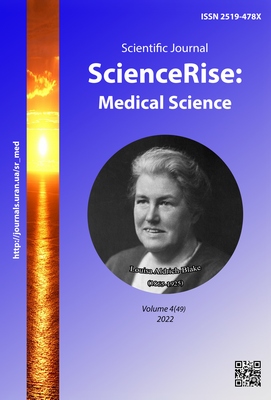Порівняння гістограм об’єму доз та сечового міхура та прямої кишки у хворих на рак шийки матки, яких лікували за допомогою внутрішньопорожнинної брахітерапії у відділенні променевої терапії
DOI:
https://doi.org/10.15587/2519-4798.2022.262104Ключові слова:
міжнародна комісія радіаційних одиниць і вимірювань, внутрішньопорожнинна брахітерапія, зовнішня променева терапіяАнотація
Мета: оцінка двовимірного точкового планування дози та тривимірної комп’ютерної томографії на основі параметрів доза-об’єм для внутрішньопорожнинної брахітерапії раку шийки матки з використанням високої дози.
Матеріали та методи: проспективне дослідження, проведено в період з червня 2018 року по квітень 2020 року, загалом за участю 50 проспективно зареєстрованих жінок з неметастатичною карциномою шийки матки, які отримували остаточну одночасну хіміо-променеву терапію з подальшою внутрішньопорожнинною брахітерапією з ВПД, які відповідали критеріям, були включені в дослідження. Всі жінки отримували 50 Гр EBRT, потім було проведено оцінку відповідей та адекватності для зручного введення аплікації. Процедуру брахітерапії проводили під седацією в літотомічному положенні.
Результати: Середній вік усієї групи за медіаною становив 54,5 року, більшість із них були на 5-му (34 %) або 4-му (28 %) десятку років. Патоморфологічно всі мали плоскоклітинний рак. Найбільш поширеним підтипом був великоклітинний незроговілий тип (64 %). Основну частину дослідження становлять стадії IIA, IIB, IIIB. Усіх пацієнтів лікували зовнішньою променевою терапією 50 Гр у 25 фракціях з 2 Гр на фракцію з наступною брахітерапією високою потужністю 7 Гр на фракцію протягом 3 фракцій з інтервалом в один тиждень до загальної внутрішньопорожнинної дози брахітерапії 21 Гр.
Висновки: Результати дослідження свідчать про те, що референтні точки ICRU прямої кишки можуть бути сурогатними маркерами для D2cc, але не для сечового міхура, і, отже, звітування бажано робити за допомогою об’ємного методу, а не контрольних точок для різних доз
Посилання
- Bray, F., Ferlay, J., Soerjomataram, I., Siegel, R. L., Torre, L. A., Jemal, A. (2020). Global cancer statistics 2018: GLOBOCAN estimates of incidence and mortality worldwide for 36 cancers in 185 countries. CA: A Cancer Journal for Clinicians, 68 (6), 394–424. doi: http://doi.org/10.3322/caac.21492
- Global strategy to accelerate the elimination of cervical cancer as a public health problem and its associated goals and targets for the period 2020-2030. Resolution WHA73.2 Report: EB144/28 Agenda item 6.5 – Accelerating cervical cancer elimination.
- Seltzer, S. M., Bartlett, D. T., Burns, D. T., Dietze, G., Menzel, H.-G., Paretzke, H. G., Wambersie, A. (2011). The International Commission on Radiation Units and Measurements. Journal of the ICRU, 11 (1). doi: http://doi.org/10.1093/jicru/ndr011
- Yang, X., Li, Z., Cai, Z., Tang, X., Liu, J., Cui, S., Li, M. (2022). Optimizing the IPSA Conditions to Improve the Treatment Plan Quality in Brachytherapy for Cervical Cancer. Journal of Oncology, 1–13. doi: http://doi.org/10.1155/2022/6499744
- Wenkstetten-Holub, A., Fangmeyer-Binder, M. Fasching, P. (2021). Prevalence of comorbidities in elderly cancer patients. Memo, 14 (1), 15–19. doi: http://doi.org/10.1007/s12254-020-00657-2
- Jamema, S. V., Saju, S., Mahantshetty, U., Pallad, S., Deshpande, D. D., Shrivastava, S. K., Dinshaw, K. A. (2008). Dosimetric evaluation of rectum and bladder using image-based CT planning and orthogonal radiographs with ICRU 38 recommendations in intracavitary brachytherapy. Journal of medical, 33, 3–8. doi: http://doi.org/10.4103/0971-6203.39417
- Vinod, S. K., Caldwell, K., Lau, A., Fowler, A. R. (2011). A comparison of ICRU point doses and volumetric doses of organs at risk (OARs) in brachytherapy for cervical cancer. Journal of Medical Imaging and Radiation Oncology, 55 (3), 304–310. doi: http://doi.org/10.1111/j.1754-9485.2011.02272.x
- Hashim, N., Jamalludin, Z., Ung, N. M., Ho, G. F., Malik, R. A., Ee Phua, V. C. (2014). CT Based 3-Dimensional Treatment Planning of Intracavitary Brachytherapy for Cancer of the Cervix : Comparison between Dose-Volume Histograms and ICRU Point Doses to the Rectum and Bladder. Asian Pacific Journal of Cancer Prevention. Asian Pacific Organization for Cancer Prevention, 15 (13), 5259–5264. doi: http://doi.org/10.7314/apjcp.2014.15.13.5259
- Lal, N., Yadav, S., Yogi, V., Singh, O. P., Ghori, H. U., Choudhary, M., Saxena, R., Saxena, S. (2022). Evaluation of dose–Volume-based image-guided high-dose-rate brachytherapy in carcinoma uterine cervix: A prospective study. Journal of Radiation and Cancer Research, 13, 12–18. doi: http://doi.org/10.4103/jrcr.jrcr_39_21
- Takenaka, T., Yoshida, K., Tachiiri, S., Yamazaki, H., Aramoto, K., Furuya, S. et. al. (2012). Comparison of dose-volume analysis between standard Manchester plan and magnetic resonance image-based plan of intracavitary brachytherapy for uterine cervical cancer. Journal of Radiation Research, 53 (5), 791–797. doi: http://doi.org/10.1093/jrr/rrs033
- Tan, L. T. (2011). Implementation of image-guided brachytherapy for cervix cancer in the UK: progress update. Clinical Oncology, 23 (10), 681–684. doi: http://doi.org/10.1016/j.clon.2011.07.011
- Nancy, E., Crawford, A. S., Manuel, J. (2005). Quality of Life Among Younger Women With Breast Cancer: Journal of Clinical Oncology, 23 (15), 3322–3330. doi: http://doi.org/10.1200/jco.2005.05.130
- Gómez, L, Andrés, C, Ruiz, A. (2017). Dosimetric impact in the dose-volume histograms of rectal and vesical wall contouring in prostate cancer IMRT treatments. Reports of Practical Oncology & Radiotherapy, 22 (3), 223–230. doi: http://doi.org/10.1016/j.rpor.2017.02.005
##submission.downloads##
Опубліковано
Як цитувати
Номер
Розділ
Ліцензія
Авторське право (c) 2022 Munagapati Vishnu Priya, Gandi Joseph Benjamin, Rasapalli Vineeth Sagar

Ця робота ліцензується відповідно до Creative Commons Attribution 4.0 International License.
Наше видання використовує положення про авторські права Creative Commons CC BY для журналів відкритого доступу.
Автори, які публікуються у цьому журналі, погоджуються з наступними умовами:
1. Автори залишають за собою право на авторство своєї роботи та передають журналу право першої публікації цієї роботи на умовах ліцензії Creative Commons CC BY, котра дозволяє іншим особам вільно розповсюджувати опубліковану роботу з обов'язковим посиланням на авторів оригінальної роботи та першу публікацію роботи у цьому журналі.
2. Автори мають право укладати самостійні додаткові угоди щодо неексклюзивного розповсюдження роботи у тому вигляді, в якому вона була опублікована цим журналом (наприклад, розміщувати роботу в електронному сховищі установи або публікувати у складі монографії), за умови збереження посилання на першу публікацію роботи у цьому журналі.










